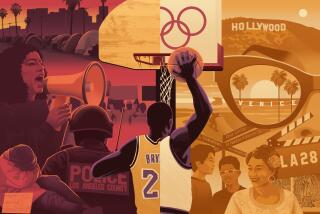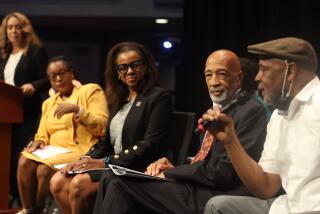Ethnic Groups Look to Future as Crisis Passes
- Share via
For many residents of Los Angeles, this weekend was the final chapter in a long and wrenching year of living dangerously. The crisis passed. Peace reigned. Justice--at least in part--emerged triumphant.
But for some among the city’s myriad ethnic groups, Saturday’s verdicts came as little more than a momentary respite for a city that is as divided and angry as it was before anyone had ever heard of Rodney Glen King.
And in the aftermath of the King case, leaders of the African-American, Latino and Asian-American communities face a daunting question: Where do we go from here?
“Now that the trial is over, the real trial has begun,” said the Rev. Cecil (Chip) Murray of First African Methodist Episcopal Church.
Last spring’s riots--and the specter of a reprise this year--had become a galvanizing force, providing focus and power to long-ignored ethnic communities for empowerment, justice and social change. They also brought international attention to the problems of Los Angeles.
With the trial past and the world’s press on the first flight home, residents and community leaders face the difficult task of grappling with the problems that did not go away.
“We can’t afford to relax just because the immediate crisis is gone,” said Stewart Kwoh, president of the Asian Pacific American Legal Center. “The causes that led to the uprising last year, other than the spark (the not guilty verdicts in the state trial of the four officers accused in the King beating), are still there.”
Looming above the struggle to forge a course for the future is the specter of the sentencing of the two convicted LAPD officers, as well as the trial of the men accused of beating trucker Reginald O. Denny at Florence and Normandie avenues.
The new verdicts have provided the opportunity, some community leaders say, to turn away from thoughts of arming toward larger issues of social injustice.
Pointing the way, the Rev. Benjamin F. Chavis Jr., the newly selected executive director of the National Assn. for the Advancement of Colored People, flew into Los Angeles from Washington and took up residence in a public housing project, where he awaited the outcome of the trial.
“Our eyes have to be on the longer prize,” Chavis said in Jordan Downs. “We need justice, but we also need education, child care and health care.”
For some, the lesson learned from the riots is that African-Americans, Latinos and Asian-Americans must first get their own houses in order, strengthen their communities before the delicate process of coalition building begins. Self-reliance is the foundation of a strong coalition.
“Blacks have to pull together. No one is going to do anything for us,” said Bessie Conley, a nurse who lives in South-Central Los Angeles. “If we learned anything, we have learned that blacks have to stick together.”
For Latinos, the upheaval provided an opportunity to attempt to heal old wounds.
On the eve of the King verdicts, an impressive array of elected Latino lawmakers gathered publicly to stress unity. Forgotten for the day were the feuding factions and the often-conflicting interests of the Eastside Mexican-American Establishment and the immigrant neighborhoods housing hundreds of thousands of recent arrivals from Central America and Mexico.
And Asian-Americans recently overcame a tradition of ethnic loyalties to form the Asian Pacific Americans for a New Los Angeles, a consortium of 40 Asian-American groups.
The easing of tensions after the verdicts also has provided an opening for building inter-ethnic coalitions.
“We need to get beyond fighting over the crumbs for our share of the pie,” said Oscar Andrade, executive director of El Rescate, a social service group for Central American immigrants. “The time has come for all of us, people of color, to work together for something positive.”
In an unprecedented step on the eve of the verdicts, Chavis called on Asian-Americans and Latinos to join the largest and oldest civil rights organization in the country, the NAACP.
Los Angeles is a “barometer for the nation’s urban ills,” he said. And with its large multiethnic population, he added, there is a need for African-Americans to form coalitions with other groups to force change.
Community leaders agree that if any good came from the riots, it was that the chaos helped galvanize communities to face problems that had simmered for years.
“Through the riots and the verdicts we have gone through a lot of pain and suffering, but we also learned some valuable lessons,” said Sang-Ju Lee, a Koreatown pharmacist. “Those lessons are that Korean-Americans cannot separate themselves from the plight of the poor in many inner-city communities.”
Still, the last year has underscored the differences among racial and ethnic groups.
“It’s pretty sad, looking at the state of ethnic relations in Los Angeles,” said Naomi Bradley, 33, a South-Central resident who is the executive director of a youth center. “Not only is there the King beating, (but) the possibility of the school district breaking up, the disbanding of the Black-Korean Alliance. Things like this make you feel pessimistic. There’s not a lot of hope.”
California’s recession has only intensified political and economic competition.
“The city is still separated and there is no mechanism for people to sit down and rub elbows,” Bradley said. “People have to be more compassionate--in law enforcement, in criminal justice system, housing, redevelopment.”
Some minority residents say that the year of turmoil was a squandered opportunity to forge greater unity between people of color in Los Angeles, who now outnumber Anglos.
With the cameras gone, the struggle to keep the spotlight on fundamental social change is even more difficult, they say.
Nowhere was that more evident on Sunday than on the corner of Florence and Normandie. Less than 24 hours earlier, journalists from around the world had flocked to the intersection, seeking reaction to the verdicts. By Sunday, streets were empty at the symbolic center of the riots.
“No one really cares. No one is really going to turn things around for us,” Conley said.
But Jay Shim, owner of Bourbon Street Liquor, two doors from Lee’s Drugs at the corner of Vermont and Olympic, said going it alone only repeats the errors of the past.
Although African-Americans, Latinos and Asian-Americans now make up a majority of Los Angeles, no one group has achieved the political or economic muscle to force change in the city.
Shim said that because of the relatively small number of Korean-Americans in Los Angeles, they have felt as if they are caught in a power struggle between blacks and whites.
The fear of another upheaval in Koreatown was one of the most powerful forces within the Korean-American community. Korean-Americans concentrated on protecting their businesses and battling the movement to decrease the number of liquor stores across the city.
Korean-Americans, like other ethnic groups, recognize now that their problems are intrinsically intertwined with those of African-American and Latinos.
“As long as the conditions that led those people to erupt in anger exist, we are vulnerable,” said Koreatown pharmacist Sang-Ju Lee, whose business has never recovered from the riots. “And, as long as we don’t have articulate spokesmen for our community, we will continue to be politically impotent.”
At the same time, hopes were raised among many African-Americans that their devastated communities would receive a greater slice of the economic pie.
“Expectations were raised, but then hopes were dashed,” said Eric Crumpton, a Crenshaw-area real estate investor. “The very people who want to go out on their own may not be able to do it. There needs to be a vehicle available in the black community to show them the way. Training and financing. People have the drive and ambition to make it but they don’t always have the know-how or capital.”
Asian-American groups have begun to work with African-American and Latino organizations to build multiethnic agendas, and the ranks of bilingual and bicultural Asian-American leaders are growing.
Marcia Choo, program director of the Asian Pacific American Dispute Resolution Center, said her organization and the Martin Luther King Dispute Resolution Center have quietly prevented potential problems, although “television isn’t around” to report on these “positive stories.”
Recently, the two organizations were instrumental in getting an African-American contractor to work on a Korean-American managed construction project. After an angry group of African-Americans shut down the project because only Korean-Americans and Latinos were working, two dispute resolution centers got involved.
Within days, an agreement was reached and Robert Bridges, an African-American contractor, was hired by Moon Chung, establishing an economic partnership that political talk and posturing do not accomplish.
“When Robert Bridges and Moon Chung sat down, it was not about race, but one businessman talking to another businessman,” Choo said.
Latinos have undertaken similar cross-ethnic initiatives. One group, the Watts/Century Latino Organization, has been credited with reaching out to African-Americans in South-Central Los Angeles, home to large numbers of new Latino immigrants.
“In terms of achieving beneficial social policies, no one community is going to be strong enough to achieve that by itself,” said Lisa Duran, an organizer with the Labor / Community Strategy Center, a nonprofit advocacy group.
Jorge R. Mancillas, a representative of the Mexican-American Political Assn., said: “I think it’s an illusion to think that one group can, or should, achieve its goals separately.”
And since the riots, social and cultural exchanges between African-American and Korean-American communities have increased significantly. On April 29, the two communities plan a joint service commemorating the first anniversary of the riots at the Congregation Church of Christ, an African-American church at the border of South-Central and Koreatown. At the invitation of religious and civic organizations, numerous African-American leaders have visited South Korea.
“We have to lose the idea of separatism, particularly among minorities but also with the majority,” said Juan Zamora, an El Salvadoran shoemaker who heads a group of Latino merchants. “Divisions have damaged us for too many years”
More to Read
Sign up for Essential California
The most important California stories and recommendations in your inbox every morning.
You may occasionally receive promotional content from the Los Angeles Times.











